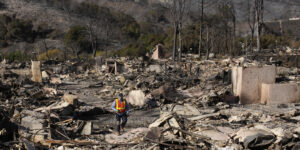Homeowners insurance is notably cyclical, and carriers depend on the profitability of calmer years to offset anticipated losses during exceptionally bad storm seasons. However, as catastrophic weather events brought on by climate change become more frequent and severe, carriers are faced with a tough choice: raise premiums or exit the markets where coverage is needed most.
No industry can persist where costs continually outweigh profits. Over the past decade, damages caused by wildfires, wind, hailstorms, floods, and hurricanes have all increased, which has forced carriers to reconsider what they can feasibly underwrite and where. This shift not only reshapes industry practices, but also leaves many homeowners vulnerable to significant financial harm if insurers can’t sustain their business.
A larger population now lives in environments where climate risk is growing.
Historically predictable weather patterns are growing more erratic, with extreme events becoming common. Storms that were once outliers are now the norm. This has changed baseline levels of risk across the U.S., and inland regions previously regarded as safe are now subject to frequent natural disasters, especially wildfires.
According to a recent New York Times report, in 2023 wildfires and other storms pushed 2.5 million American adults out of their homes, including at least 830,000 people who were displaced for six months or longer. Despite this elevated risk, in recent years more homes have been built in high-risk environments: there are now more than 16 million homes currently in fire-prone areas near forests, grasslands and shrub lands, up from 10 million in 1990.
The reality of underwriting for climate change leads carriers to withdraw from several states.
Given these worsening environmental conditions, effectively underwriting for homeowners insurance poses a major challenge to carriers. Traditional risk assessment methods that rely heavily on an insurer’s own historical datasets are yielding fewer pathways to profitability, thus many insurers are adopting more stringent criteria with higher premiums and reduced coverage options. Even with these efforts, in some cases carriers simply can’t make the numbers work.
In California, State Farm and Allstate stopped issuing new home insurance policies as of 2023, citing the unsustainable costs of insuring properties in wildfire-prone areas, as well as the rising price of reinsurance. Farmers reached a similar conclusion and exited Florida the same year, and several carriers elsewhere along the Gulf Coast withdrew from Louisiana due to the similar threat of worsening hurricanes. But customers in storm-prone Midwest states such as Iowa, too, have fewer options for coverage, with at least four carriers leaving in 2024 on account of dangerous loss ratios that were impossible to recoup.
This trend of state-level withdrawal is particularly concerning, as entire regions may be deemed uninsurable by major carriers. When left with no competitive choices on the open market, homeowners must turn to state-backed insurance programs, which often provide only limited protection and may come with higher costs.
Regulators are responding, but more solutions are necessary.
With the 2024 wildfire and hurricane season now underway, state regulators are taking action to maintain market stability and protect consumers. Earlier in August, California’s Department of Insurance imposed a one-year moratorium preventing insurers from dropping coverage for homeowners in certain areas affected by recent wildfires. This temporary measure provides some relief, though it highlights the need for longer-term solutions that protect the end-insured and help ensure a sustainable business model for carriers.
In recent reports centered on and reinsurance, Deloitte has recommended that regulators work closely with insurers to develop innovative risk management strategies, such as (where insurers and reinsurers offload risks to the larger capital markets through high-yield securities), both of which could offer more resilient solutions in the face of climate-induced disasters. Deloitte’s analysis underscores the importance of public-private partnerships to bolster the industry’s capacity for managing and distributing risk effectively.
Additionally, the Insurance Institute for Business & Home Safety, or I.B.H.S., is advocating for new building and landscaping practices that would help mitigate wildfire damage to suburban neighborhoods. By enforcing stricter building regulations in high-risk areas, state governments can limit their residents’ overall exposure to catastrophic losses, thus easing the burden on insurers and restoring competition (and lower premiums, ideally) to the insurance market in their states.
Technology offers carriers greater precision for managing uncertainty.
Absent larger legislative efforts to curb the impacts of climate change, insurers will need to develop more sophisticated risk models that properly account for worsening losses across larger swaths of the country. This means leveraging smarter technology to better analyze real-time data and predict risks with greater precision.
There may be more shifts toward collaborative approaches to risk management, where insurers, governments, and communities work together to enhance resilience. This could include investments in climate-resistant infrastructure, revised zoning laws, and increased public awareness of the importance of disaster preparedness. Routine fire mitigation is already a fact of life for many homeowners in the West, and it will surely become one for many more.
As the impacts of climate change grow in scope and cost, the role of the insurance industry in safeguarding communities and supporting economic stability will be increasingly critical.
Vertafore’s ImageRight and Reference Connect can help insurers better navigate climate change challenges by efficiently managing data, accelerating claims processing, and enabling more accurate risk assessment for underwriting decisions.




















 Empowering the ‘Semi-Captive’ Agent: A New Playbook for Insurers
Empowering the ‘Semi-Captive’ Agent: A New Playbook for Insurers  Southern California Wildfires Spark Interest in Natural Building Materials
Southern California Wildfires Spark Interest in Natural Building Materials  P/C Insurance Market Profitability Expected to Continue Through 2026
P/C Insurance Market Profitability Expected to Continue Through 2026  Leading Insurance Innovation in the AI Age (Part 1: Culture)
Leading Insurance Innovation in the AI Age (Part 1: Culture) 




